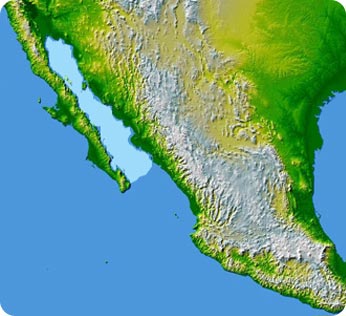In 1940, novelist John Steinbeck sailed into the Gulf of California with his friend, marine scientist Edward Ricketts. They cruised the gulf for six weeks, gathering scientific samples, doing a little fishing, and enjoying the gulf’s tranquil beauty. Their work provided the first in-depth look at life in the gulf. And the two books they published popularized another name for it: the Sea of Cortez.
 The Sea of Cortez highlighted in light blue. Credit: Wikipedia
The Sea of Cortez highlighted in light blue. Credit: WikipediaThe sea is still attracting researchers, fishermen, and tourists. And despite some of the same problems facing other bodies of water, it still teems with life -- almost a thousand species of fish, mammals, and reptiles.
The Sea of Cortez stretches almost 700 miles between Baja California and the mainland of Mexico. It formed several million years ago, when two plates of Earth’s crust moved apart, separating Baja from the mainland.
In a way, the Sea of Cortez is like two seas in one.
The northern end is shallow, partially filled in by sediments from the Colorado River. Life in this part of the sea is dominated by creatures that hang around all year, including the world’s smallest porpoise. More about that in our next show.
The southern end is deep, and includes fish and mammals that migrate to other parts of the oceans. The roster of life includes some of the largest creatures on the planet: giant squid and manta rays, white and whale sharks, and the biggest of all, the blue whale.
These creatures help make the Sea of Cortez one of the most biologically diverse bodies of water in the world.

